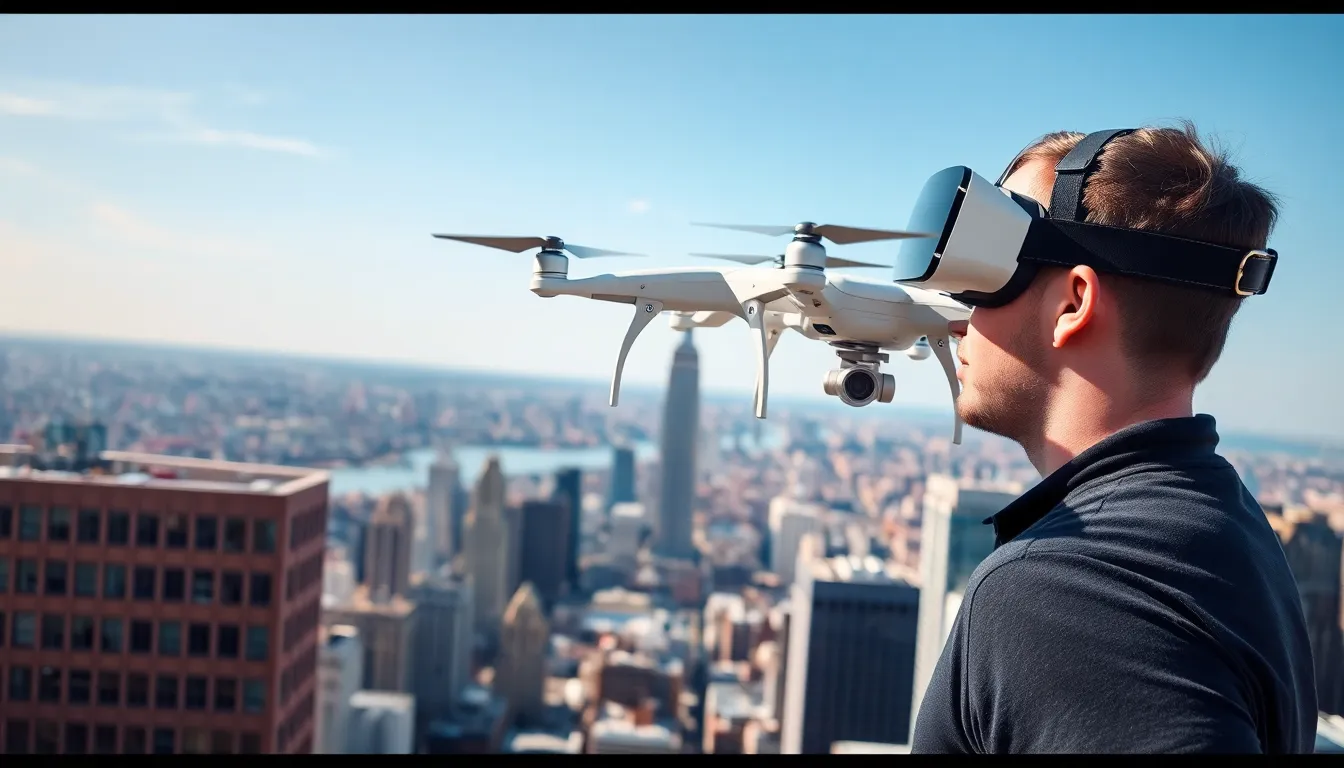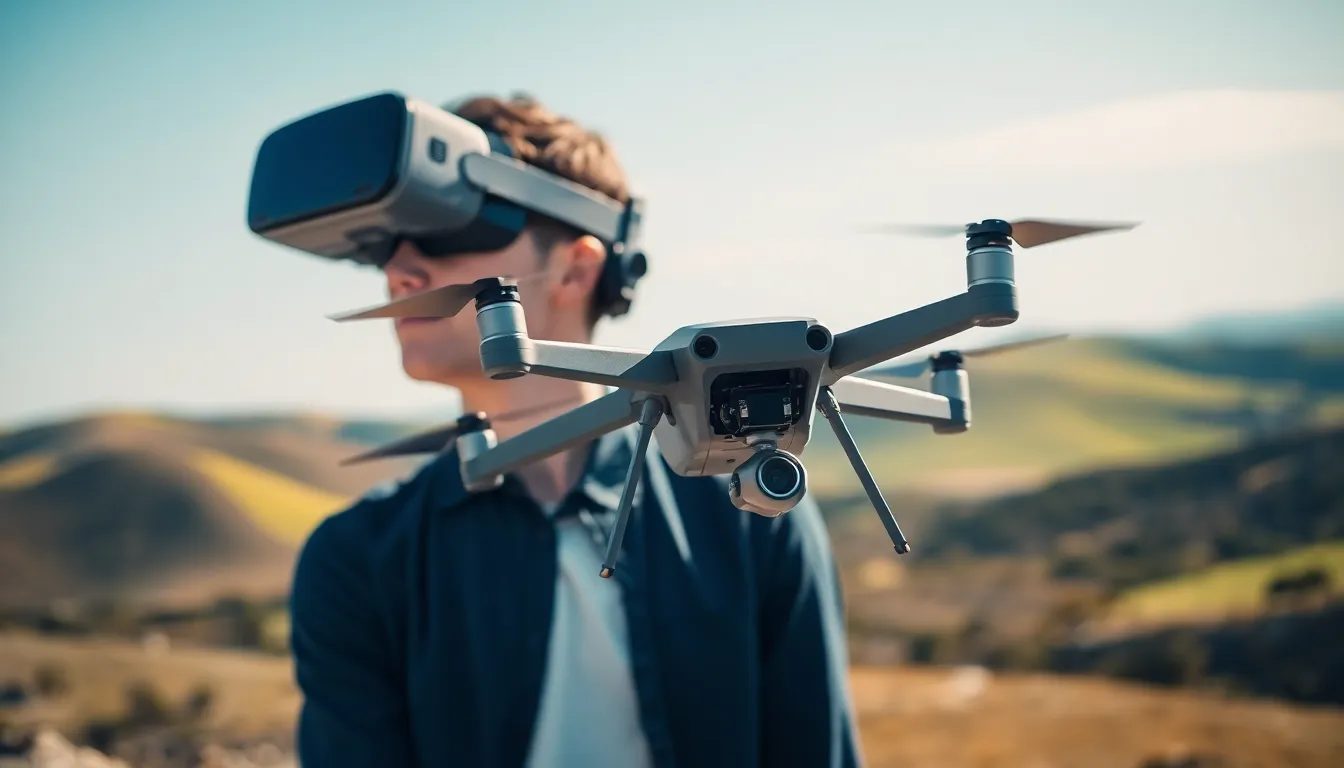Imagine soaring through the sky without leaving your couch. Sounds like a dream, right? Welcome to the thrilling world of virtual reality drones, where the sky’s not the limit—it’s just the beginning. These high-tech gadgets combine the excitement of flying with the immersive experience of virtual reality, letting users explore breathtaking landscapes and capture stunning aerial footage like never before.
Table of Contents
ToggleOverview of Virtual Reality Drones
Virtual reality drones represent a significant technological advancement in the realm of unmanned aerial vehicles. They allow users to experience immersive flight simulations through headsets, creating a lifelike view from above. Users can navigate vibrant landscapes while piloting these drones, enhancing overall engagement and interaction.
Capturing stunning aerial footage becomes effortless with advanced camera technologies integrated into virtual reality drones. High-definition cameras enable filming in 4K resolution, offering impressive image clarity. Recording options provide various perspectives, enriching the user’s video library.
Drones equipped with virtual reality capabilities facilitate both recreational and professional uses. Real estate professionals utilize these devices for aerial property views, while filmmakers appreciate their ability to capture cinematic scenes from unique angles. Educational institutions employ these drones for practical training, emphasizing their versatility across sectors.
Safety features are critical components in the design of virtual reality drones. Many models incorporate obstacle avoidance systems, assisting pilots in avoiding collisions during flight. Live streaming capabilities enhance experiences by enabling audiences to share or view drone footage in real time.
Exploration of remote areas becomes possible via virtual reality drones. Piloting through rugged terrains offers insights into places that may be difficult to access otherwise. Enthusiasts frequently utilize this technology to enrich their outdoor adventures or document nature.
Overall, virtual reality drones provide innovative experiences, combining flight technology with visual immersion. As the industry continues to grow, advancements will likely enhance capabilities, making these devices even more valuable to users.
Key Features of Virtual Reality Drones

Virtual reality drones offer unique functionalities that enhance user experiences. They integrate technology to provide captivating, immersive interaction during flights.
Immersive Experience
Participants enjoy a 360-degree view when using virtual reality headsets. This fully immersive experience allows users to feel as if they’re soaring through the skies. Enhanced visuals provide stunning landscapes, making the flight feel more genuine. Users can even look around while piloting, engaging with the environment as they control the drone. The combination of realistic textures and dynamic imagery elevates the overall enjoyment. Flying over breathtaking terrains or urban landscapes becomes a thrilling adventure through an engaging, virtual environment.
Advanced Control Mechanisms
Precision in control is essential for effective piloting. Virtual reality drones feature intuitive controls that respond seamlessly to user inputs. Advanced sensors enable real-time feedback, allowing for smooth navigation. Features such as gesture recognition and head tracking contribute to enhanced maneuverability. Users enjoy the simplicity of adjusting flight paths, making operation feel effortless. These mechanisms improve both recreational flying and professional applications, ensuring users maintain control even in complex scenarios. The advanced control systems establish a new standard for drone operation, merging technology with user-friendly design.
Applications of Virtual Reality Drones
Virtual reality drones find numerous applications across various sectors. Their capabilities enhance experiences and drive innovation.
Entertainment and Gaming
Gaming experiences transform significantly with virtual reality drones. Players can navigate virtual worlds while controlling drones, creating immersive gameplay. These drones allow users to explore expansive terrains from unique perspectives, enhancing the thrill of outdoor adventures. Events like drone racing capture attention, as competitors engage in high-speed competitions while viewing the action through headsets. Such innovative gaming formats attract both casual players and avid enthusiasts, broadening entertainment options.
Training and Simulation
Training professionals in various fields benefits immensely from virtual reality drones. For instance, pilots undergo realistic flight simulations, practicing maneuvers in controlled environments. Emergency responders utilize drone simulations to prepare for real-world scenarios, improving decision-making skills. Incorporating virtual reality into training sessions enhances knowledge retention and engagement. Organizations leverage drones to reduce training costs while maximizing effectiveness, ultimately leading to safer operations in the field.
Research and Development
Research initiatives gain momentum with virtual reality drones. These drones gather data in hard-to-reach areas, essential for environmental studies and wildlife monitoring. Scientists analyze aerial footage to assess ecosystem changes or track animal behavior effectively. Additionally, 3D mapping applications support urban planning efforts by providing detailed aerial views. Innovative developers experiment with VR drones to advance technology, pushing the boundaries of what drones can achieve in various research domains.
Benefits of Using Virtual Reality Drones
Virtual reality drones offer significant advantages by enhancing user experiences and improving training outcomes. These benefits span various sectors, showcasing the versatility of this technology.
Enhanced User Engagement
Enhanced engagement stands out as a primary benefit of virtual reality drones. Users enjoy immersive experiences that stimulate emotional responses and heighten their interest. With a 360-degree view, participants feel present in the flight environment, making the adventure more captivating. Interactivity with the drone’s controls adds another layer of excitement, as users navigate through stunning locations effortlessly. Offering stunning aerial views, the drones also cater to both amateur and professional videographers, expanding content creation opportunities. Audiences can experience breathtaking imagery while live streaming, fostering community interaction and collective viewing experiences.
Improved Training Efficiency
Improved efficiency in training becomes evident when using virtual reality drones. Trainees simulate real-world scenarios, enhancing learning and skill acquisition. Professionals, such as pilots and emergency responders, practice complex missions without the risks associated with traditional training methods. Access to realistic environments leads to better decision-making and faster response times in actual situations. Moreover, the cost-effectiveness stems from reduced need for physical resources, eliminating expensive equipment and travel expenses. By creating a safe, controlled setup, virtual reality drones optimize training programs across multiple fields, leading to more knowledgeable and responsive personnel.
Challenges and Limitations
Virtual reality drones face several challenges and limitations that impact their effectiveness and widespread adoption.
Technical Limitations
Technical limitations hinder the performance of virtual reality drones significantly. Battery life remains a primary concern, impacting flight duration and user experience. Most consumer drones offer varying flight times, typically between 20 to 30 minutes, which constrains exploration. Latency issues can arise between drone signals and headset displays, leading to disorientation for users. Connectivity problems may occur in congested areas or remote locations, resulting in loss of control. Additionally, weight restrictions affect the integration of advanced technologies, such as higher-resolution cameras or enhanced sensors.
Regulatory Issues
Regulatory issues present additional challenges for virtual reality drone users. Compliance with local laws and regulations becomes essential, as numerous regions impose strict guidelines on drone operation. Airspace restrictions limit flight activities, particularly in populated areas or near airports. Privacy concerns arise from capturing footage of private properties without consent, raising ethical questions. Moreover, drone operators must often secure specific permits for commercial use, complicating professional applications. These regulations create a complex landscape for users, requiring adherence to multiple criteria to operate legally and safely.
Virtual reality drones are revolutionizing the way users experience flight and explore the world from above. This innovative technology not only enhances recreational activities but also offers significant benefits in professional fields like real estate and education. As advancements continue to emerge, these drones are set to become even more versatile and user-friendly.
Despite facing challenges like battery life and regulatory hurdles, the potential for virtual reality drones remains immense. Their ability to provide immersive experiences while ensuring safety and engagement makes them an exciting frontier in both entertainment and training. As the industry evolves, users can look forward to more sophisticated features that will further enrich their aerial adventures.



